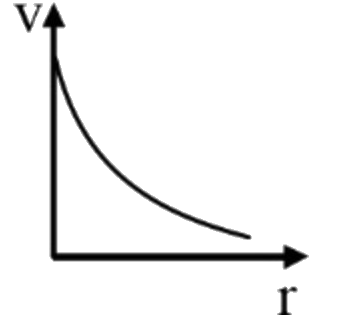Terminal velocity (V) of a spherical object varies with a radius of object (r) -




The correct Answer is:A
To solve the problem regarding the relationship between terminal velocity (V) and the radius (r) of a spherical object, we can follow these steps:
1. Understanding Terminal Velocity:
Terminal velocity is the constant speed that a freely falling object eventually reaches when the resistance of the medium prevents further acceleration. For a spherical object falling through a viscous medium, the forces acting on it are the gravitational force (downward) and the drag force (upward).
2. Forces Acting on the Object:
- The gravitational force acting on the object is given by Fg=mg, where m is the mass of the object and g is the acceleration due to gravity.
- The drag force acting on the object can be expressed as Fd=6πηrV, where η is the coefficient of viscosity, r is the radius of the spherical object, and V is the terminal velocity.
3. Setting Up the Equation:
At terminal velocity, the drag force equals the gravitational force:
mg=6πηrV
4. Expressing Mass in Terms of Density:
The mass m can be expressed in terms of the density of the object ρ and its volume. The volume V of a sphere is given by V=43πr3, so:
m=ρ⋅V=ρ⋅43πr3
5. Substituting Mass into the Equation:
Substituting m into the force balance equation gives:
ρ⋅43πr3g=6πηrV
6. Simplifying the Equation:
Canceling π from both sides and rearranging gives:
43ρr2g=6ηV
V=29ρgr2η
7. Identifying the Relationship:
From the final equation, we can see that terminal velocity V is proportional to the square of the radius r:
V∝r2
8. Graphical Representation:
The relationship V∝r2 indicates that if we were to plot terminal velocity V against radius r, the graph would be a parabola opening upwards. However, since the radius cannot be negative, the graph will only exist in the first quadrant.
Conclusion:
The terminal velocity V of a spherical object varies with the square of its radius r as V∝r2.
Terminal velocity is the constant speed that a freely falling object eventually reaches when the resistance of the medium prevents further acceleration. For a spherical object falling through a viscous medium, the forces acting on it are the gravitational force (downward) and the drag force (upward).
- The gravitational force acting on the object is given by Fg=mg, where m is the mass of the object and g is the acceleration due to gravity.
- The drag force acting on the object can be expressed as Fd=6πηrV, where η is the coefficient of viscosity, r is the radius of the spherical object, and V is the terminal velocity.
At terminal velocity, the drag force equals the gravitational force:
mg=6πηrV
The mass m can be expressed in terms of the density of the object ρ and its volume. The volume V of a sphere is given by V=43πr3, so:
m=ρ⋅V=ρ⋅43πr3
Substituting m into the force balance equation gives:
ρ⋅43πr3g=6πηrV
Canceling π from both sides and rearranging gives:
43ρr2g=6ηV
V=29ρgr2η
From the final equation, we can see that terminal velocity V is proportional to the square of the radius r:
V∝r2
The relationship V∝r2 indicates that if we were to plot terminal velocity V against radius r, the graph would be a parabola opening upwards. However, since the radius cannot be negative, the graph will only exist in the first quadrant.
The terminal velocity V of a spherical object varies with the square of its radius r as V∝r2.
Topper's Solved these Questions
Similar Questions
Knowledge Check
The terminal velocity V of a spherical ball of lead of radius R falling through a viscous liquid varies with R such that
AVR= ConstantBVR= constantCV= constantDVR2= constantThe nature of graph between terminal velocity of spherical body vs the square of its radius is
Aexpoentially increasin curveBstaight lineCparabolaDexponentially decreasing curveAs a spherical wavefront propagates, the amplitude (a) of a spherical wavefront varies with the distance r of the source
Ainversely as √r i.r., a ∝1√rBinversely as r i.r., a ∝1rCdirectly as r i.r., a∝rDdirectly as √r i.e., ∝√r
Define escape velocity of an object.
View SolutionThe velocity v of moving object varies with displacement u as v=3x^(2)-2 ,then the acceleration at x=2m is
View SolutionDraw a graph between terminal velocity of a spherical body and square of its radius?
View SolutionA small spherical ball falling through a viscous medium of negligible density has terminal velocity v. Another ball of the same mass but of radius twice that of the earlier falling through the same viscous medium will have terminal velocity
View SolutionThe terminal velocity of small sized spherical body of radius r falling vertically in a viscous liquid is given by the following proportionality
View Solution
